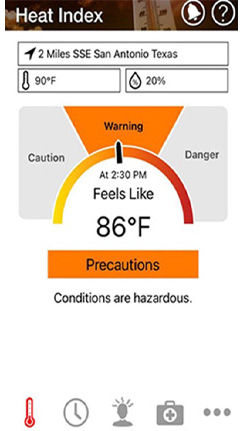6 best practices to minimize the impact of heat stress

The increasing frequency of heatwaves and record temperatures across the country has led to elevated concerns about heat-related illnesses and accidents. Five states have already enacted heat standards to protect workers, and a proposed rule has been submitted by Federal OSHA.
Within the workplace, the impact of heat stress is a significant concern for both workers and employers. When not properly controlled, heat stress can impair a worker’s cognitive and motor functions. This results in increased risk of injury to the affected worker as well as others who may be affected by the tasks that worker is doing, such as operating equipment or machinery. Additionally, heat stress lowers productivity and increases the likelihood of errors that impact quality.
How heat stress happens
Heat stress occurs when the body cannot cool itself effectively. When the body absorbs and/or creates more heat than it can release, the core temperature rises, placing increased stress on vital organs. This is most often due to high temperatures in the work environment, but is also related to factors like humidity, workload, clothing, hydration, and personal factors such as age and medical conditions. These factors can impact a worker’s ability to benefit from sweat evaporation, the body’s main cooling mechanism.
According to the National Weather Service, heat kills more Americans than any other kind of weather-related death in the United States1
OSHA refers to the direct health issues resulting from heat stress as Heat-Related Illnesses (HRI), which include heat rashes, heat cramps, heat exhaustion or, in severe cases, heatstroke, which can be life-threatening. Even without leading to an HRI, heat stress can cause symptoms that increase the risk of injury while performing work tasks, such as heavy sweating, dizziness, nausea, fatigue, muscle weakness, loss of balance, reduced mental awareness, loss of grip, and decreased reaction time.
Who is impacted?
Heat stress affects various industries and work environments. Workers who spend extended periods outdoors in direct sunlight, on hot surfaces like asphalt, or near heat-producing equipment are particularly at risk. Those in hot indoor environments, areas with limited airflow, or near high heat equipment are also at risk, as are employees whose tasks require high levels of physical activity, are done in high humidity, or requires clothing that traps heat or restricts sweat evaporation. New employees who have not been allowed to slowly adjust to working in a hot environment are at greater risk.
Six best practices for preventing heat stress in the workplace
Effectively managing heat-related risks is crucial for maintaining a safe and productive workplace. Follow these best practices to develop a heat illness prevention program and minimize the risk to your employees and businesses. Check for any additional state requirements and stay updated on the Federal Heat Stress Standard rule-making process by visiting OSHA's website.
- Identify heat hazards
- Hazard identification: Regularly check for heat exposure risks in different job roles and settings, focusing on high-risk areas and tasks, especially during hot periods.
- Temperature monitoring: Use systems to continuously monitor temperature and humidity levels, especially during heat waves or extreme heat.

- Planning and monitoring
- Plan ahead: Assess weather forecasts and physical work demands to create a daily plan for managing heat stress.
- Designate a heat safety coordinator: Assign an individual to monitor conditions and employees’ well-being in extreme temperatures.
- Monitor conditions: Keep track of temperature and humidity throughout the day, adjusting the work plan as necessary. For outdoor work, you can use the free NIOSH/OSHA Heat Safety Tool App (see screen image at right).
- Identify risks and take preventative steps
- Identify risk factors: Recognize environmental factors like sun exposure, air temperature, humidity, radiant heat from machinery, and air movement.
- Cooling measures: Use wet towels or ice to help reduce heat stress.
- Shade and cooling areas: Schedule regular breaks in cool or shaded areas to help workers recover from heat. Increase the number and length of breaks as temperatures rise.
- Acclimatization programs: Create plans to help new and returning workers gradually increase their workloads and exposure time to build heat tolerance. For example, start with shorter work periods and gradually increase the duration over a week.
- Rest breaks: Schedule regular breaks in cool or shaded areas to help workers recover from heat and increase the number and length of breaks as temperatures rise
- Adjust work schedules: Avoid working during the hottest parts of the day and increase rest breaks.
- Hydration: Avoid dehydration by steering clear of caffeine, sugary drinks, and alcohol. Provide water and electrolyte-based drinks regularly.
- Appropriate clothing: Encourage lightweight, breathable clothing and limit time in heavy or heat-retaining personal protective equipment (PPE).
- Training and education
- Pre-work meetings: Discuss symptoms of heat-related illnesses, expected conditions, and safety measures before starting work.
- Heat safety training: Teach employees and supervisors about the risks of heat illnesses, their symptoms, and how to prevent them. Training should include recognizing early signs of heat stress and providing first aid.
- Annual refresher training: Provide annual refresher training to everyone, along with extra training after changes in heat exposure, company policies, or after a heat-related incident.
- Emergency preparedness
- Emergency medical response: Develop an emergency response plan and train employees on its implementation, including first aid and medical assistance and calling 911.
- Heat injury and illness prevention plan (HIIPP): Employers should create and follow a written HIIPP. This plan, which should be reviewed annually and after any serious heat-related incident, should include specific information to evaluate and control heat hazards.
- Documentation
- Recordkeeping: Use OSHA forms or similar recordkeeping measures to keep track of monitoring data, injury and illness records, and environmental monitoring data. These forms can be adapted to include data like temperature, humidity, and other relevant information.
- Review documentation: Routinely review records and incident logs to identify successful program results and where improvement opportunities may exist. Use employee and management teams to help in this process.
Summary
By implementing these best practices, employers can protect their workers, enhance productivity, and ensure compliance with safety regulations. For further guidance, review OSHA’s Heat Illness Prevention Campaign at osha.gov/heat.
References
1 National Weather Service, “Weather Related Fatality and Injury Statistics,” available at https://www.weather.gov/hazstat/
